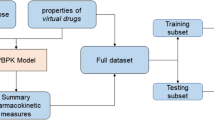Abstract
Current measures of the performance of computer-controlled infusion pumps (CCIPs) are poorly defined, of little use to the clinician using the CCIP, and pharmacostatistically incorrect. We propose four measures be used to quantitate the performance of CCIPs: median absolute performance error (MDAPE), median performance error (MDPE), divergence, and wobble. These measures offer several significant advantages over previous measures. First, their definitions are based on the performance error as a fraction of the predicted (rather than measured) drug concentration, making the measures much more useful to the clinician. Second, the measures are defined in a way that addresses the pharmacostatistical issue of appropriate estimation of population parameters. Finally, the measure of inaccuracy, MDAPE, is defined in a way that is consistent with iteratively reweighted least squares nonlinear regression, a commonly used method of estimating pharmacokinetic parameters. These measures make it possible to quantitate the overall performance of a CCIP or to compare the predictive performance of CCIPs which differ in either general approach (e.g., compartmental model driven vs. plasma efflux approach), pump mechanics, software algorithms, or pharmacokinetic parameter sets.
Similar content being viewed by others
References
J. M. Alvis, J. G. Reves, A. V. Govier, P. G. Menkhaus, C. E. Henling, J. A. Spain, and E. Bradley. Computer-assisted continuous infusions of fentanyl during cardiac anesthesia: Comparison with a manual method.Anesthesiology 63:41–49 (1985).
M. E. Ausems, D. R. Stanski, and C. C. Hug. An evaluation of the accuracy of pharmacokinetic data for the computer assisted infusion of alfentanil.Br. J. Anaesth. 57:1217–1225 (1985).
D. P. Crankshaw, M. D. Boyd, and A. R. Bjorksten. Plasma drug efflux—A new approach to optimization of drug infusion for constant blood concentration of thiopental and methohexital.Anesthesiology 67:32–41 (1987).
S. L. Shafer, L. C. Siegel, J. E. Cooke, and J. C. Scott. Testing computer-controlled infusion pumps by simulation.Anesthesiology 68:261–266 (1988).
D. B. Raemer, A. Buschman, J. R. Varvel, B. K. Philip. M. D. Johnson, D. A. Stein, and S. L. Shafer. The prospective use of population pharmacokinetics in a computer-driven infusion system for alfentanil.Anesthesiology 73:66–72 (1990).
M. Michiels, R. Hendriks, and J. Heykants. A sensitive radioimmunoassay for fentanyl: Plasma level in dogs and man.Eur. J. Clin. Pharmacol. 12:153–158 (1977).
P. O. Maitre, S. Vozeh, J. Heykants, D. A. Thomson, and D. R. Stanski. Population pharmacokinetics of alfentanil: The average dose-plasma concentration relationship and interindividual variability in patients.Anesthesiology 66:3–12 (1987).
J. C. Scott and D. R. Stanski. Decreased fentanyl and alfentanil requirements with age: A simultaneous pharmacokinetic and pharmacodynamic evaluation.J. Pharmacol. Exp. Ther. 240:159–166 (1987).
P. O. Maitre, M. E. Ausems, S. Vozeh, and D. R. Stanski. Evaluating the accuracy of using population pharmacokinetic data to predict plasma concentrations of alfentanil.Anesthesiology 68:59–67 (1988).
M. Gibaldi and D. Perrier.Pharmacokinetics, 2nd ed., Marcel Dekker, New York, 1982.
L. Wilkinson.SYSTAT: The System for Statistics, SYSTAT, Inc., Evanston, IL, 1988.
L. B. Sheiner. The population approach to pharmacokinetic data analysis: Rationale and standard data analysis methods.Drug. Metab. Rev. 15:153–171 (1984).
W. J. Dixon and F. J. Massey.Introduction to Statistical Analysis, 3rd ed., McGraw-Hill, New York, 1969.
R. J. Carroll and D. Ruppert.Transformation and Weighting in Regression, Chapman and Hall, London, 1988.
S. Vozeh, P. O. Maitre, and D. R. Stanski. Evaluation of population (NONMEM) pharmacokinetic parameter estimates.J. Pharmacokin. Biopharm. 18:161–173 (1990).
S. L. Shafer, G. M. Martinez, D. R. Stanski, and J. C. Scott. Pharmacokinetic analysis of fentanyl administered by a computer controlled infusion pump.Anesthesiology 67:A666 (1987).
L. B. Sheiner and S. L. Beal. Some suggestions for measuring predictive performance.J. Pharmacokin. Biopharm. 9:503–512 (1981).
P. O. Maitre and D. R. Stanski. Bayesian forecasting improves the prediction of intraoperative plasma concentrations of alfentanil.Anesthesiology 69:652–659 (1988).
S. L. Shafer, J. R. Varvel, N. Aziz, and J. C. Scott. The performance of pharmacokinetic parameters derived from a computer controlled infusion pump.Anesthesiology 69:A460 (1988).
P. Glass, J. R. Jacobs, E. D. Hawkins, B. Ginsberg, T. J. Quill, and J. G. Reeves. Accuracy and efficacy of a pharmacokinetic model-driven device to infuse fentanyl for anesthesia during general surgery.Anesthesiology 69:A290 (1988).
S. L. Shafer, J. R. Varvel, N. Aziz, and J. C. Scott. Pharmacokinetics of fentanyl administered by computer-controlled infusion pump.Anesthesiology 73:1091–1102 (1990).
P. Glass, J. R. Jacobs, L. R. Smith, B. Ginsberg, T. J. Quill, S. A. Bai, and J. G. Reves. Pharmacokinetic model-driven infusion of fentanyl: assessment of accuracy.Anesthesiology 73:1082–1090 (1990).
R. J. Serfling.Approximation Theorems of Mathematical Statistics, Wiley, New York, 1980.
P. J. Huber.Robust Statistics, Wiley, New York, 1982.
F. J. Anscombe and J. W. Tukey. The examination and analysis of residuals,Technometrics, Vol. 5, 1963.
D. C. Hoaglin, F. Mosteller, and J. W. Tukey.Understanding Robust and Exploratory Data Analysis, Wiley, New York, 1983.
F. Mosteller and J. W. Tukey.Data Analysis and Regression: A Second Course, Addison Wesley, Reading, MA, 1977.
D. B. Raemer, A. Buschman, M. D. Johnson, B. K. Philip, S. L. Shafer, and D. R. Stanski. Alfentanil pharmacokinetic model applied to ambulatory surgical patients: Does a computerized infusion improve predictability?Anesthesiology 69:A243 (1988).
Author information
Authors and Affiliations
Rights and permissions
About this article
Cite this article
Varvel, J.R., Donoho, D.L. & Shafer, S.L. Measuring the predictive performance of computer-controlled infusion pumps. Journal of Pharmacokinetics and Biopharmaceutics 20, 63–94 (1992). https://doi.org/10.1007/BF01143186
Received:
Revised:
Published:
Issue Date:
DOI: https://doi.org/10.1007/BF01143186




